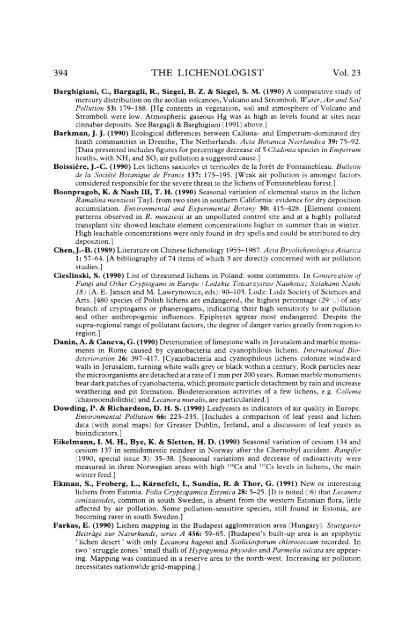Literature on Air Pollution and Lichens XXXIV
Literature on Air Pollution and Lichens XXXIV
Literature on Air Pollution and Lichens XXXIV
Create successful ePaper yourself
Turn your PDF publications into a flip-book with our unique Google optimized e-Paper software.
394 THE LICHENOLOGIST Vol.23<br />
Barghigiani, C, Bargagli, R., Siegel, B. Z. & Siegel, S. M. (1990) A comparative study of<br />
mercury distributi<strong>on</strong> <strong>on</strong> the aeolian volcanoes, Vulcano <strong>and</strong> Stromboli. Water, <strong>Air</strong> <strong>and</strong> Soil<br />
Polluti<strong>on</strong> 53: 179-188. [Hg c<strong>on</strong>tents in vegetati<strong>on</strong>, soil <strong>and</strong> atmosphere of Volcano <strong>and</strong><br />
Stromboli were low. Atmospheric gaseous Hg was as high as levels found at sites near<br />
cinnabar deposits. See Bargagli & Barghigiani (1991) above.]<br />
Barkman, J. J. (1990) Ecological differences between Calluna- <strong>and</strong> Empetrum-dominated dry<br />
heath communities in Drenthe, The Netherl<strong>and</strong>s. Ada Botamca Neerl<strong>and</strong>ica 39: 75-92.<br />
[Data presented includes figuresfor percentage decrease of 5 Clad<strong>on</strong>ia species in Empetrum<br />
heaths, with NH, <strong>and</strong> SO, air polluti<strong>on</strong> a suggested cause.]<br />
Boissiere, J.-C. (1990) Les lichens saxicoles et terricoles de la foret de F<strong>on</strong>tainebleau. Bulletin<br />
de la Societe Botanique de France 137: 175-195. [Weak air polluti<strong>on</strong> is am<strong>on</strong>gst factors<br />
c<strong>on</strong>sidered resp<strong>on</strong>sible for the severe threat to the lichens of F<strong>on</strong>tainebleau forest.]<br />
Bo<strong>on</strong>pragob, K. & Nash III, T. H. (1990) Seas<strong>on</strong>al variati<strong>on</strong> of elemental status in the lichen<br />
Ramalina menziesii Tayl. from two sites in southern California: evidence for dry depositi<strong>on</strong><br />
accumulati<strong>on</strong>. Envir<strong>on</strong>mental <strong>and</strong> Experimental Botany 30: 415^428. [Element c<strong>on</strong>tent<br />
patterns observed in R. menziesii at an unpolluted c<strong>on</strong>trol site <strong>and</strong> at a highly polluted<br />
transplant site showed leachate element c<strong>on</strong>centrati<strong>on</strong>s higher in summer than in winter.<br />
High teachable c<strong>on</strong>centrati<strong>on</strong>s were <strong>on</strong>ly found in dry spells <strong>and</strong> could be attributed to dry<br />
depositi<strong>on</strong>.]<br />
Chen,J.-B. (1989) <str<strong>on</strong>g>Literature</str<strong>on</strong>g> <strong>on</strong> Chinese lichenology 1955-1987. Acta Bryolichenologica Asiatica<br />
1: 57-64. [A bibliography of 74 items of which 3 are directly c<strong>on</strong>cerned with air polluti<strong>on</strong><br />
studies.]<br />
Cieslinski, S. (1990) List of threatened lichens in Pol<strong>and</strong>: some comments. In C<strong>on</strong>servati<strong>on</strong> of<br />
Fungi <strong>and</strong> Other Cryptogams in Europe ' Lodzkie Towarzystwo Naukowe; Szlakami Nauki<br />
18) (A. E. Jansen <strong>and</strong> M. Lawrynowicz, eds): 90-103. Lodz: Lodz Society of Sciences <strong>and</strong><br />
Arts. [480 species of Polish lichens are endangered, the highest percentage (29",,) of any<br />
branch of cryptogams or phanerogams, indicating their high sensitivity to air polluti<strong>on</strong><br />
<strong>and</strong> other anthropogenic influences. Epiphytes appear most endangered. Despite the<br />
supra-regi<strong>on</strong>al range of pollutant factors, the degree of danger varies greatly from regi<strong>on</strong> to<br />
regi<strong>on</strong>.]<br />
Danin, A. & Caneva, G. (1990) Deteriorati<strong>on</strong> of limest<strong>on</strong>e walls in Jerusalem <strong>and</strong> marble m<strong>on</strong>uments<br />
in Rome caused by cyanobacteria <strong>and</strong> cyanophilous lichens. Internati<strong>on</strong>al Biodeteriorati<strong>on</strong><br />
26: 397-417. [Cyanobacteria <strong>and</strong> cyanophilous lichens col<strong>on</strong>ize windward<br />
walls in Jerusalem, turning white walls grey or black within a century. Rock particles near<br />
the microorganisms are detached at a rate of 1 mm per 200 years. Roman marble m<strong>on</strong>uments<br />
bear dark patches of cyanobacteria, which promote particle detachment by rain <strong>and</strong> increase<br />
weathering <strong>and</strong> pit formati<strong>on</strong>. Biodeteriorati<strong>on</strong> activities of a few lichens, e.g. Collema<br />
(chasmoendolithic) <strong>and</strong> Lecanora muralis, are particularized.]<br />
Dowding, P. & Richards<strong>on</strong>, D. H. S. (1990) Leafyeasts as indicators of air quality in Europe.<br />
Envir<strong>on</strong>mental Polluti<strong>on</strong> 66: 223-235. [Includes a comparis<strong>on</strong> of leaf yeast <strong>and</strong> lichen<br />
data (with z<strong>on</strong>al maps) for Greater Dublin, Irel<strong>and</strong>, <strong>and</strong> a discussi<strong>on</strong> of leaf yeasts as<br />
bioindicators.]<br />
Eikelmann, I. M. H., Bye, K. & Sletten, H. D. (1990) Seas<strong>on</strong>al variati<strong>on</strong> of cesium 134 <strong>and</strong><br />
cesium 137 in semidomestic reindeer in Norway after the Chernobyl accident. Rangifer<br />
(1990, special issue 3): 35-38. [Seas<strong>on</strong>al variati<strong>on</strong>s <strong>and</strong> decrease of radioactivity were<br />
measured in three Norwegian areas with high 134 Cs <strong>and</strong> " v Cs levels in lichens, the main<br />
winter feed.]<br />
Ekman, S., Froberg, L., Karnefelt, I., Sundin, R. & Thor, G. (1991) New or interesting<br />
lichens from Est<strong>on</strong>ia. Folia Cryptogamica Est<strong>on</strong>ica 28: 5-25. [It is noted (:6) that Lecanora<br />
c<strong>on</strong>izaeoides, comm<strong>on</strong> in south Sweden, is absent from the western Est<strong>on</strong>ian flora, little<br />
affected by air polluti<strong>on</strong>. Some polluti<strong>on</strong>-sensitive species, still found in Est<strong>on</strong>ia, are<br />
becoming rarer in south Sweden.]<br />
Farkas, E. (1990) Lichen mapping in the Budapest agglomerati<strong>on</strong> area (Hungary). Stuttgarter<br />
Beitrdge zur Naturkunde, series A 456: 59-65. [Budapest's built-up area is an epiphytic<br />
' lichen desert' with <strong>on</strong>ly Lecanora hagenii <strong>and</strong> Scoliciosporum chlorococcum recorded. In<br />
two ' struggle z<strong>on</strong>es ' small thalli of Hypogymnia physodes <strong>and</strong> Parmelia sulcata are appearing.<br />
Mapping was c<strong>on</strong>tinued in a reserve area to the north-west. Increasing air polluti<strong>on</strong><br />
necessitates nati<strong>on</strong>wide grid-mapping.]
















